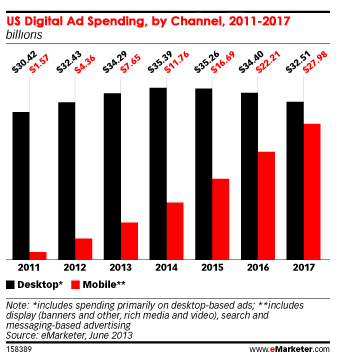Beware: As Mobile Grows, Desktop May Decline
I’ve been in the digital advertising and technology business since the 1990s, and since day one, I’ve heard two refrains over and over again: Time spent on desktops is still much greater than the dollars spent reaching the audience using them. This is the year of mobile. My reaction to this has been: Nod sagely, […]
I’ve been in the digital advertising and technology business since the 1990s, and since day one, I’ve heard two refrains over and over again:
- Time spent on desktops is still much greater than the dollars spent reaching the audience using them.
- This is the year of mobile.
My reaction to this has been:
- Nod sagely, talk about the demise of the :30-second spot (on TV).
- Laugh. Another “year of mobile”? Sure thing, you bet – just like last year.
So, as you might imagine, it has come as a bit of a shock to me to realize that the money spent on digital advertising on desktops has reached its zenith. Now, we may actually start to see the decline.
A couple of weeks ago, eMarketer distributed a report with a subheading, “As mobile gains ground, spending on desktop banners and search are poised for decline.” This is interesting since just this past November, I was reading reports that display was going to overtake search by 2015. What’s going on here? Why the sudden change in the forecast?
First of all, we as an industry have done a lousy job of defining what’s what. We talk about banners, video, rich media, display, etc. Yet, all of these ad formats can run on desktops, tablets and smartphones — and, as often as not, we mix our numbers together so that banners on mobile Web are included as banners, and then factored into the growth of display advertising. We also tend to blend tablets in with smartphones and call it all “mobile,” despite usage stats which imply that tables are used more like desktops. As a result, industry stats have become misleading.
Investors have been talking about a “mobile first” strategy for at least five years. The iPhone was launched in 2007, the first Android devices came out in 2008, the iPad was launched in early 2010, and Android tablets came online the following year. The number of people I know without a smartphone or tablet is becoming increasingly smaller.
And guess what? We use tablets and smartphones for a variety of online activities — surfing the Web, using apps, etc. — and the time on these devices is cannibalistic to time spent online. While mobile usage does increase the overall time spent with a digital device, it also decreases the time spent on desktops. (For example, I know that when I read an article from The Economist on my tablet, I don’t read it again on my computer or on my phone.)
So, although digital advertising is growing, a majority of that growth is happening on smartphones and tablets. As tablet and smartphone usage increases faster than the growth of digital advertising, it comes at the expense of the desktop. In other words, time spent engaging with advertising content on desktops is declining.
In light of this shift, there are a couple of key points worth noting.
1. Desktops Are the New Print
Just as newspapers were in denial for years about the changes going on in their business (i.e., getting crushed by the Internet), the same thing is going to happen to those who have businesses built around desktop advertising. If you have an advertising business that is driven by desktop ads, you’d better evolve it — or you will be crushed by mobile.
2. Mobile Is Different
It may look like there are only two platforms on mobile, but in fact, all the apps that were built on these platforms were built using different tools. Integrating with those tools to deliver advertising is extremely complex — not difficult, per se, but time-consuming and arcane.
Mobile is not as simplistic as desktop advertising is. First, the ecosystem of buyers and sellers and intermediaries for mobile is not the same as the one for display. Second, there are fewer of them, and they are more complicated to work with.
Although it’s true that we still spend more time on digital devices than dollars are spent on those platforms, mobile has now come of age. And, unlike last year, looking ahead to 2014 and 2015, mobile is going to take a big bite out of desktop advertising budgets.
Opinions expressed in this article are those of the guest author and not necessarily MarTech. Staff authors are listed here.
Related stories
